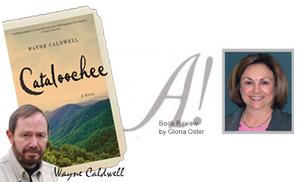

Cataloochee, an area of western North Carolina in the Great Smoky Mountains National Park, exists as one of the most inaccessible parts of the Park.The National Park Service's website communicates its beauty and remoteness:
Cataloochee Valley is nestled among some of the most rugged mountains in the southeastern United States. Surrounded by 6,000-foot peaks, this isolated valley was the largest and most prosperous settlement in what is now the Great Smoky Mountains National Park. Once known or its farms and orchards, today Cataloochee is one of the most picturesque areas of the park....The challenge is getting there.
Cataloochee, Wayne Caldwell's first novel, creates a "history" spanning three generations, documenting life in this mountain enclave before the area became federal property. Beginning right after the Civil War, the story features two families, the Carters and the Banks. The story proceeds in a panoramic fashion, rather than focusing on detailed and intimate individual characterizations. Readers can follow the fortunes, failures, and foibles of these two families in a general way - until the last few pages of the novel.
As the novel draws to a close in the 1920s, the story becomes more focused on several of the characters involved in a dramatic incident occurring on page two of the Prologue. Jake Carter, a major character in the novel's conclusion, is repairing his roof when "...as he stepped up [the ladder], a gunshot cracked in the autumn air - which nearly cost him his footing." Jake heads toward the sound of the shot, his brother-in-law's farm. He doesn't arrive there until page 277. At this point, the story intensifies because the characters develop more. One reason is the source of the gunshot. Another reason readers gradually become aware of is the anticipated acquisition of the land to establish the National Park. The hostility and turmoil generated among residents of Cataloochee who must deal with a "Yankee government" create forceful dialogue and reveal more about the individual characters than the previous 275 pages.
Readers know what happens to the government's intent to acquire the land for a national park; but they don't know what Jake will find when he arrives at the farm and what will ensue as a result. Both events show the characters' attributes clearly.
So, what happens between page two and page 277? Caldwell writes how Cataloochee's settlement expands as families grow and prosper. A major touchstone in the tale is Ezra Banks, who comes to Asheville after his stint with the Confederate Army. Ezra's eye for making money becomes the financial measure of Cataloochee's prosperity, and his flint-hard heart the emotional measure of other characters in the novel.
Ezra marries Hannah Carter, the daughter of Haywood County's most landed apple farmer. A prolific family, the Carters marry and move to various points in the county.
The author moves circuitously through the histories of Carter and Banks parents and children, providing background to their births, marriages, and deaths as well as portraying slices of daily life that document the changing times. Sears catalogs, Burdick sewing machines, government taxes on liquor, trains, Model-Ts, and lemon Jell- O appear appropriately and attest to the seeping in of modernity.
On the other hand, the idiosyncratic qualities of mountain ways and speech are given their due, too. Readers experience the hardships unfavorable weather can bring to farmers, the violent deaths that result when human-kind attempts to tame a wilderness, funerals conducted in below-freezing cold of winter. These finely-drawn details give the community of Cataloochee historical authenticity.
Toward the book's end, Rass Carter, one of Cataloochee's third generation, rides his mule to the top of a mountain to worm the family's cattle. As he looks around the bald, he spies "...a pair of birds his mother called 'wood hens' and his father called 'Lord God birds' and Mr. Frazier [his teacher] called 'pileated woodpeckers'...." Rass's innocent musings about different terms for ordinary sights in Cataloochee epitomize the infiltration of the outside world and predict its future.
The organization of the novel, plus the detached tone of the narrator in relating a myriad of common and extraordinary events, works to make the story quite different from the obvious comparison a reader might want to make with Charles Frazier's use of western North Carolina as the subjects of Cold Mountain and Thirteen Moons.
Caldwell also leaves a few obvious conflicts unresolved. The novel ends with Cataloochee's preacher asking for the Lord's help in "bestowing upon me your voice so you can give them strength for their next year's journey, wherever it might lead, amen." Caldwell orchestrates a worthwhile and wellwritten journey through Cataloochee's past, and he may be planning another journey for residents of Cataloochee. As the characters are becoming more well-defined, this journey may prove even more interesting than the previous one.
About the Reviewer: Gloria Oster teaches in the School of Education at King College and is a member of the Arts Alliance Mountain Empire's A! Magazine for the Arts committee.
Meet the Author of Cataloochee.